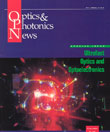
May 1992 Issue
- The Revolution in Femtosecond Near-infrared Pulse Generation
- Modelocked Semiconductor Lasers: Short Pulse, Small Package!
- An Ultrafast Optoelectronic THz Beam System: Applications to Time-Domain Spectroscopy
- Ultrashort Pulse Fiber Lasers
- Ultrafast Spectroscopy of Semiconductors
- Update on the Modulation Transfer Function
- Getting It Together on U.S. Optical Standards
- Colored Shadows and Retinex Vision
- Browse all Issues
Feature Articles
The Revolution in Femtosecond Near-infrared Pulse Generation
Revolution or just plain old evolution? In the field of femtosecond optical pulse generation, rapid changes have been taking place in the last year. Is it ultrafast evolution? While not on the same scale as the changes i n the former Soviet Union and Eastern Europe, researchers in the field everywhere have had a hard time trying to keep track of and keep up with the pace of new developments. In this article, we would like to track the progress in the field of femtosecond optical pulse generation in the near infrared and discuss the current state of the art.
by W. H. KnoxModelocked Semiconductor Lasers: Short Pulse, Small Package!
Researchers have long recognized the potential for short pulse generation using the semiconductor laser medium. Soon after room temperature CW operation in semiconductor lasers was obtained, the first reported modelocking results occurred in the early 1970s. Like dye lasers or Ti:sapphire lasers, the gain-bandwidth of semiconductor lasers can span many THz, allowing the generation of femtosecond optical pulses. With the use of semiconductor materials, modelocked lasers are now important in many applications that were previously infeasible or uneconomical.
by D.J. Derickson, R.J. Helkey, A. Mar, J.G. Wasserbauer, W.B. Jiang and J.E. BowersAn Ultrafast Optoelectronic THz Beam System: Applications to Time-Domain Spectroscopy
Recently, there has been a great deal of work demonstrating the generation of THz radiation (1 THz = 33.3 cm-1 = 4.1 meV) via material and electronic excitation by ultrashort laser pulses. Modern integrated circuit techniques have made possible the precise fabrication of micron-sized dipoles, which, when photoconductively driven by fsec laser pulses, can radiate well into the THz regime. An alternative and complimentary approach has been to extend radio and microwave techniques into the THz regime through the use of optoelectronic antennas. Other sources based on various physical systems and effects include the emission of an electromagnetic shock wave due to a volume dipole distribution moving faster than the phase velocity in the medium, i.e., electro-optic Cherenkov radiation, and the electromagnetic shock wave radiated by a surface-dipole distribution propagating faster than the phase velocity in the substrate.
by D. GrischkowskyUltrashort Pulse Fiber Lasers
For years people have been looking for a compact, electrically efficient, inexpensive source of optical pulses less than one picosecond in duration for scientific investigation, optical probing, and, more recently, for high bit rate communication or computing systems. The early promises of modelocked diode lasers fell prey to low reliability and large intrapulse frequency chirp. When the first singlemode rare-earth-doped optical fiber was drawn in 1973, no one could predict the impact that this development would eventually have. Since then, we have seen fiber become the preferred method of communications transmission, and the rare-earth-doped optical fiber the preferred method of optical amplification. It is not surprising, then, that there has also been a significant effort to use the wide bandwidth of the rare-earth-doped fiber gain transition to make a laser to produce ultra-short pulses. In its most elegant form, this laser would be all fiber, diode laser pumped, and capable of producing pulses of less than half a picosecond.
by Irl N. Duling IIIUltrafast Spectroscopy of Semiconductors
Since the first realization of modelocking of a ruby laser in 1965, ultrafast laser technology has made tremendous progress. Today, laser pulses as short as 6 fsec can be generated with dye laser based systems. Yet, from our point of view, the progress is not just in the availability of short laser pulses, but also in the reliability and stability of today's laser systems, which in some cases can be comparable to that of cw lasers.
by Ernst O. GobelUpdate on the Modulation Transfer Function
This article discusses methods of calculating and measuring the MTF of a lens using some of the currently available software. Other examples of the application of PC based measurement and computation systems available to the engineer today would be of interest. Submission of material on this subject to the editor of this column is encouraged.
by Bruce H. WalkerGetting It Together on U.S. Optical Standards
In the U.S., almost any organization can write standards. If certain rules of fairness and objectivity are observed during the writing, these standards can become the American National Standards Institute (ANSI) national standards. However, if the writing organization keeps the copyright, these standards are not listed in the ANSI standards, but only in the publisher's list and in some privately published catalogs of standards. Even in these catalogs, standards relating to optics are seldom indexed under optics, but rather under the field in which they are used. For example, standards relating to methods of measuring waviness in sheet glass are listed as architectural standards because they are used for selecting window glass. Only by having a good idea of where to look, can these standards based on optical methods be located.
by Robert E. ParksColored Shadows and Retinex Vision
When the sun is low at the end of a clear winter day, the long shadows of trees against the snow look violet-blue in comparison to the gold sunlight. As sunset progresses and the sunlight becomes redder, the shadows may look green. A controlled experiment will show that, in general, shadows of objects that are illuminated in colored light will be the complementary colors in the presence of a white light background illumination.
by Susan Houde-Walter
![Illustration of optical skyrmions. [Y. Shen]](https://opnmedia.blob.core.windows.net/$web/opn/media/images/articles/2025/0525/departments/202505-cover-web.jpg?ext=.jpg)
![Illustration of a synapse in the brain. [Getty Images]](https://opnmedia.blob.core.windows.net/$web/opn/media/images/articles/2025/0425/departments/202504-cover-web.jpg?ext=.jpg)
![Fiber draped around a hand, demonstrating its flexibility. [Photo by Z. Wang and L. Wei]](https://opnmedia.blob.core.windows.net/$web/opn/media/images/articles/2025/0325/departments/202503-cover-web.jpg?ext=.jpg)